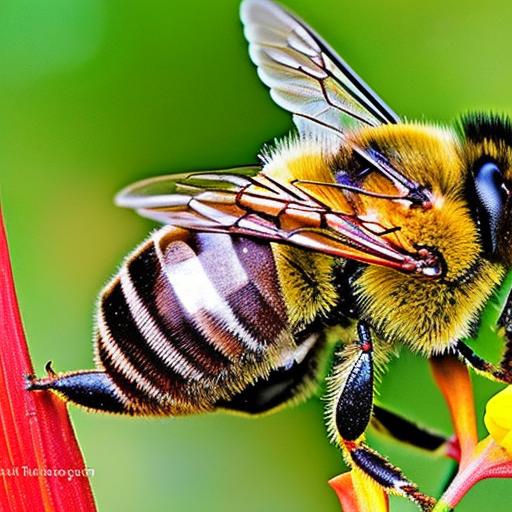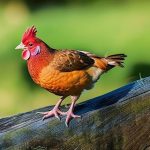Keeping bees and chickens together is a practice that is gaining popularity among backyard farmers and homesteaders. It involves housing beehives and chicken coops in close proximity to each other, allowing the two species to coexist and benefit from each other’s presence. This practice has numerous benefits, including increased pollination for plants and crops, natural pest control, reduced stress for chickens, and increased honey production. By understanding the behavior of bees and chickens, choosing the right location, maintaining a safe distance, providing adequate shelter and protection, and implementing strategies to minimize conflict, it is possible to create a harmonious environment where bees and chickens thrive together.
Key Takeaways
- Keeping bees and chickens together can be beneficial for both species.
- Before keeping bees near chickens, it’s important to consider factors such as space and safety.
- Understanding the behavior of bees and chickens can help minimize conflict between the two.
- Choosing the right location for beehives and chicken coops is crucial for their well-being.
- Providing adequate shelter and protection for bees and chickens is essential for their survival.
Benefits of Keeping Bees and Chickens in Close Proximity
One of the main benefits of keeping bees and chickens together is increased pollination for plants and crops. Bees are known for their role as pollinators, transferring pollen from male to female flowers, which leads to fertilization and the production of fruits and seeds. By having beehives near gardens or crops, the bees will visit the flowers more frequently, resulting in improved pollination rates and higher yields.
Another benefit is natural pest control. Chickens are excellent at foraging for insects, including pests that can damage plants or crops. By allowing chickens to roam freely near gardens or crops, they will help control populations of harmful insects, reducing the need for chemical pesticides.
Keeping bees near chickens also has advantages for the chickens themselves. The presence of bees can help reduce stress in chickens by providing a calming effect. The gentle humming sound of bees can have a soothing effect on chickens, helping to keep them calm and relaxed.
Lastly, keeping bees near chickens can lead to increased honey production. Bees require nectar from flowers to produce honey, and by having beehives near gardens or crops, the bees will have a readily available source of nectar. This can result in higher honey yields, providing a delicious reward for the beekeeper.
Considerations Before Keeping Bees Near Chickens
Before deciding to keep bees near chickens, there are several important considerations to keep in mind. First, it is essential to check local regulations and laws regarding beekeeping and chicken keeping. Some areas may have restrictions or requirements that need to be followed, such as obtaining permits or meeting specific zoning requirements.
Another consideration is allergies and safety concerns. Some people may be allergic to bee stings, so it is important to assess the risk and take necessary precautions. Additionally, it is crucial to ensure that the chickens are safe from potential harm caused by the bees. Chickens are generally not bothered by bees, but in rare cases, they may peck at bees and get stung. It is important to monitor the behavior of both species and intervene if necessary.
Compatibility of bee and chicken breeds is also an important consideration. Some bee breeds may be more aggressive than others, and certain chicken breeds may be more prone to pecking or disturbing the bees. It is important to choose bee and chicken breeds that are known to be compatible and have a history of coexisting peacefully.
Understanding the Behavior of Bees and Chickens
To successfully keep bees and chickens together, it is important to understand how these two species interact with each other. Bees are generally not aggressive towards chickens and will only sting if they feel threatened. Chickens, on the other hand, are generally curious about bees but do not pose a significant threat to them.
It is important to recognize signs of aggression or stress in both bees and chickens. Aggressive behavior in bees can include buzzing loudly, flying aggressively towards humans or animals, or repeatedly bumping into objects or animals. Signs of stress in chickens can include excessive feather pecking, pacing, or aggressive behavior towards other chickens or animals. By monitoring the behavior of both species, it is possible to intervene and address any issues before they escalate.
Choosing the Right Location for Beehives and Chicken Coops
Choosing the right location for beehives and chicken coops is crucial for creating a harmonious environment. Several factors should be considered when selecting a location. First, it is important to ensure that there is ample forage available for both bees and chickens. This includes a variety of flowering plants for bees to collect nectar from and open space for chickens to forage for insects and vegetation.
The location should also provide adequate shelter from extreme weather conditions. Bees and chickens both require protection from excessive heat, cold, wind, and rain. Providing shade, windbreaks, and appropriate housing can help ensure the well-being of both species.
Creating a harmonious environment also involves minimizing potential sources of conflict. For example, it is important to keep beehives away from areas where chickens may disturb them, such as near their water or food sources. Additionally, it is important to consider the flight path of bees when choosing a location for beehives, as they should not fly directly over areas where chickens spend a lot of time.
Maintaining a Safe Distance Between Bees and Chickens

Maintaining a safe distance between beehives and chicken coops is essential to minimize the risk of stings and disturbances. The appropriate distance will depend on various factors, including the temperament of the bees and chickens, the layout of the area, and local regulations.
As a general guideline, it is recommended to keep beehives at least 10 feet away from chicken coops. This distance allows bees to fly freely without being disturbed by chickens while still providing enough space for both species to coexist comfortably.
To further minimize the risk of stings, it is important to provide a clear flight path for bees. This can be achieved by placing beehives in an area where chickens are less likely to cross their flight path. Additionally, it is important to avoid placing beehives near areas where chickens congregate, such as their water or food sources.
Providing Adequate Shelter and Protection for Bees and Chickens
Providing adequate shelter and protection is crucial for creating a safe and comfortable environment for both bees and chickens. For bees, this includes providing a sturdy hive structure that protects them from the elements and predators. Beehives should be securely built and placed on a stable foundation to prevent them from toppling over or being damaged by strong winds.
For chickens, it is important to provide a secure coop that protects them from predators such as raccoons, foxes, or snakes. The coop should have a solid roof, sturdy walls, and secure doors or windows to prevent entry by predators. Additionally, it is important to provide adequate ventilation and insulation to ensure the comfort of the chickens.
To protect both bees and chickens from predators, it is important to implement additional measures such as fencing or netting. This can help deter predators from accessing the hives or coops and provide an extra layer of protection.
Strategies for Minimizing Conflict Between Bees and Chickens
To minimize conflict between bees and chickens, it is important to implement strategies that reduce competition for resources and prevent chickens from disturbing the hives.
One strategy is to provide ample forage for both bees and chickens. By ensuring that there are plenty of flowering plants for bees to collect nectar from and open space for chickens to forage for insects and vegetation, competition for resources can be minimized.
Another strategy is to provide separate water sources for bees and chickens. Bees require a water source near their hives to cool the hive and dilute honey stores. By providing a separate water source for chickens away from the beehives, the risk of chickens disturbing the bees or contaminating their water can be reduced.
To prevent chickens from disturbing the hives, it is important to provide physical barriers such as fences or netting. This can help keep chickens at a safe distance from the hives and prevent them from pecking at the bees or causing any disturbances.
Harvesting Honey and Eggs from Bees and Chickens
Harvesting honey and eggs from bees and chickens requires careful planning and execution to ensure the safety of both the beekeeper and the chickens.
When harvesting honey, it is important to wear protective clothing, including a beekeeping suit, gloves, and a veil. This will help minimize the risk of bee stings. It is also important to use proper beekeeping tools, such as a smoker, to calm the bees before opening the hive.
When collecting eggs from chickens, it is important to approach the coop calmly and quietly to avoid disturbing the chickens. It is recommended to collect eggs daily to ensure freshness and prevent them from being damaged or eaten by predators.
The Rewards of Keeping Bees and Chickens in Harmony
Keeping bees and chickens together can be a rewarding experience for backyard farmers and homesteaders. The benefits of increased pollination, natural pest control, reduced stress for chickens, and increased honey production make it an attractive practice. By understanding the behavior of bees and chickens, choosing the right location, maintaining a safe distance, providing adequate shelter and protection, and implementing strategies to minimize conflict, it is possible to create a harmonious environment where both species thrive. So why not give it a try? The joys of beekeeping and chicken raising await you!
If you’re interested in keeping bees near chickens, you may also find this article on how to insulate a chicken coop from Poultry Wizard helpful. Insulating your chicken coop not only helps keep your chickens warm during colder months but can also provide a more stable environment for your bees. Check out the article here to learn more about insulating your chicken coop and creating a suitable space for both chickens and bees.
FAQs
Can you keep bees near chickens?
Yes, it is possible to keep bees near chickens.
Is it safe to keep bees near chickens?
Yes, it is safe to keep bees near chickens as long as proper precautions are taken.
What precautions should be taken when keeping bees near chickens?
The beehives should be placed in a location that is not easily accessible to the chickens. The chickens should also have access to clean water and food to prevent them from being attracted to the beehives.
Will the chickens bother the bees?
Chickens are generally not interested in bees and will not bother them. However, if the chickens are hungry or thirsty, they may try to access the beehives.
Can bees and chickens benefit each other?
Yes, bees and chickens can benefit each other. Bees can pollinate the plants that the chickens feed on, while chickens can help control pests that may harm the bees.
What are the benefits of keeping bees and chickens together?
Keeping bees and chickens together can provide a sustainable source of food and income. The bees can produce honey and beeswax, while the chickens can provide eggs and meat. Additionally, both bees and chickens can help improve the health of the surrounding ecosystem.
Meet Walter, the feathered-friend fanatic of Florida! Nestled in the sunshine state, Walter struts through life with his feathered companions, clucking his way to happiness. With a coop that’s fancier than a five-star hotel, he’s the Don Juan of the chicken world. When he’s not teaching his hens to do the cha-cha, you’ll find him in a heated debate with his prized rooster, Sir Clucks-a-Lot. Walter’s poultry passion is no yolk; he’s the sunny-side-up guy you never knew you needed in your flock of friends!







